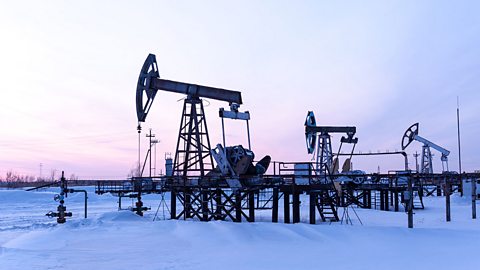What do you know?
Where is Russia?
Russia is transcontinental, which means that it lies in two continents. Russia is largely in the continent of Asia, but it also lies partly in Europe. It is a large country in the Northern Hemisphere.
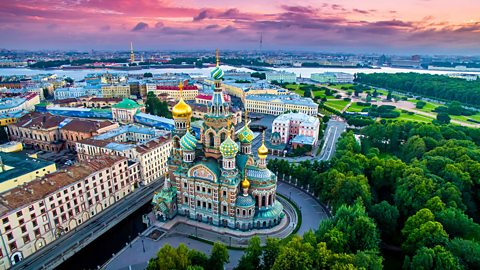
Key points
- Russia is the largest country in the world by area and it lies in the Northern Hemisphere and spans the continents of Asia and Europe.
- Russia is the ninth most populousHaving a large population. country in the world, with a population of approximately 144 million people. The major language is Russian.
- The capital city is Moscow. It lies to the west of the country and is home to around 12 million people.
- Russia contains several biomes, including tundra, taiga, temperate woodland, steppe and desert.
Activity: Explore Russia
Question
Which biome in Russia is the coldest?
The tundra biome is the coldest. It lies in the far north of Russia and the ground here can remain permanently frozen for long periods of time.
What are the physical characteristics of Russia?
Russia is the largest country in the world. It covers an area of 17,098,242 km², which is approximately 70 times greater the size of the UK. The country spans 11 time zoneImaginary lines that divide the Earth according to local time, eg hours in front of or behind Greenwich Mean Time (GMT)..
Russia is located in the Northern HemisphereAny part of the Earth that lies to the north of the Equator.. The climate is largely cold and continentalA climate with significant annual variation in temperature (hot summers and cold winters)., but wide variations in temperature and precipitationAny moisture that falls from the clouds, such as snow, rain, hail and sleet. exist due to the size of the country.
Russia contains several biomeA large region of Earth that has a certain climate and certain types of living organisms like a large-scale ecosystem eg. a tropical rainforest., examples of which include:
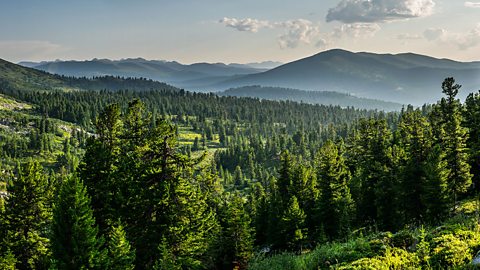
- taigaEvergreen forests that are found in cooler climates. vegetation covers most of the country. This is evergreenTrees that never lose all of their leaves, such as conifers. forest, with trees such as spruce, fir and pine.
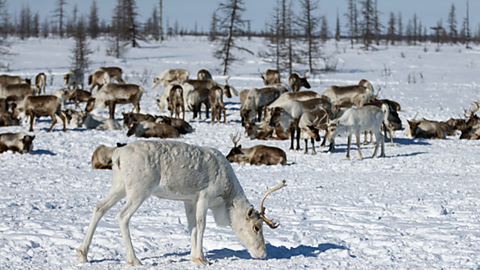
- tundraPlaces located at high latitudes. Tundra regions have very cold climates.biomes are found in the far north of Russia. Small shrubs, mossA small flowerless plant that grows in damp places. Mosses don’t have roots and so can grow in places where there is very little useable soil. and lichenA small, slow-growing organism that is often found on rocks and trees. grow, and these provide food for animals such as reindeer. Larger species of vegetation struggle to exist in the cold, dry conditions found here.
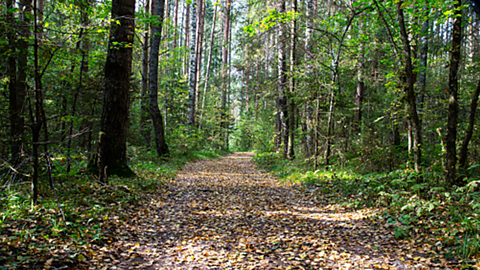
- temperate woodlandForests that are found in mild, wet climates. and steppeGrassland plains found in areas of low rainfall. biomes are found in the south of Russia. These are warmer landscapes consisting of deciduousTrees that lose their leaves once a year usually in the winter, such as oak trees. trees and grasses.

- desertAn area that receives less than 250 mm of rainfall or snow a year. are located in the far south of Russia. These areas have very little precipitation and so few plants can grow here.
This map shows the location of the different biomes across Russia.
Question
Why don’t larger species of vegetation grow in the tundra?
Many plants find it difficult to grow in the cold, dry conditions of the tundra. The tundra also has permafrostGround that remains frozen for a period of two years or more., which is where parts of the ground are permanently frozen. Larger plants would struggle to take root in frozen ground.
What are the human characteristics of Russia?
Life expectancy and literacy rates
With approximately 144 million people, Russia is the ninth most populousHaving a large population. country in the world.life expectancyThe average age that a person is expected to live. This varies from country to country. is almost 73 years, so the average person in Russia can expect to live beyond retirementThe time when a person reaches an older age and stops working. age.literacy rateThe percentage of adults that can read and write. The literacy rate in the UK is 99%. are above 99 per cent. This means that almost all Russian people can read and write.
Population distribution
Most people live in the west of the country. This is where the capital cityA city that is the administrative centre of a country. The country’s government may operate from the capital city, eg London. of Moscow and is located, as well as many other larger cities, such as St Petersburg and Kazan.Around 75 per cent of Russia’s population live in cities, where there are jobs and opportunities.Few people live in the far north, where temperatures are very low.
Watch this short video to see what life is like in Moscow, from Russia with Simon Reeve
Simon: I was heading north on the final part of my journey. Through the night to the heart of power in Russia.
Simon: It's ten past six and we are just pulling in to the station. Now we've just stopped in Moscow.
Simon: I'd never been to Moscow before. It was more beautiful than I'd imagined. The sense of power, absolute power, was tangible.
We hear a lot about the wealth of Russia, and some Russians. In reality, it's in the hands of a few.As is the power, and the privilege.
Simon: Today Moscow is a mega city. Home to twelve million people. Its infamous traffic is asymptom of rapid growth. Not that everyone needs to be stuck in a jam!
Simon: What's this lane in the middle of the road here?
Taxi Driver: You need to either work in government or have powerful friends to use it.
Simon: You need to be close to the pinnacle of power. Who's that, then? Is that somebody very important?
Taxi Driver: Bankers.
Simon: I was leaving the congested centre of Moscow. I wanted to see where most people here actually live.
Simon: It's interesting, actually. This is the sort of housing where so many Muscovites live.These massive apartment blocks.
Simon: There's also still a lot of people living in this type as well. These are known as Khrushchevkas and they're named after the former leader of the Soviet Union, Nikita Khrushchev, who first announced in the 1950s that the Soviet Union was going to begin a programme of housing construction, the like of which has never been seen before.
For many Soviet families, many Russian families, these Khrushchevkas were their first family home.And as a result, many Soviet families, many Russian families, have very warm memories of these apartment blocks.
Question
Why is the far north of Russia less populated than other areas?
Temperatures are very low in the far north of the country, so fewer people live there.
Economy
Russia is a BRICSAn acronym of the countries experiencing fast economic growth. The countries are Brazil, Russia, India, China and South Africa. economy. The BRICS are a group of countries experiencing fast economic growth.Russia’s main exportTo sell goods to other countries and send them out of the country to them. The goods are known as exports. include fossil fuelA natural fuel such as coal, oil or gas found within the Earth’s crust. Fossil fuels are formed from the remains of living organisms. (such as coal, oil and gas) and wheat. Its importTo purchase (buy) goods from abroad and bring them into a country. The goods are known as imports. include aircraft and cars.China, Germany and Belarus are major trading partnerCountries that trade with one another..
Planet Planners game. gamePlanet Planners game
Make decisions for the planet in this KS3 geography game

More on Regional study - Russia
Find out more by working through a topic
- count2 of 2
